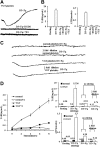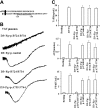The beta3 subunit of the integrin alphaIIbbeta3 regulates alphaIIb-mediated outside-in signaling
- PMID: 15701721
- PMCID: PMC1895035
- DOI: 10.1182/blood-2004-07-2718
The beta3 subunit of the integrin alphaIIbbeta3 regulates alphaIIb-mediated outside-in signaling
Abstract
Bidirectional signaling is an essential feature of alphaIIbbeta3 function. The alphaIIb cytoplasmic domain negatively regulates beta3-mediated inside-out signaling, but little is known about the regulation of alphaIIb-mediated outside-in signaling. We show that alphaIIb-mediated outside-in signaling is enhanced in platelets of a patient lacking the terminal 39 residues of the beta3 cytoplasmic tail. This enhanced signaling was detected as thromboxane A(2) (TxA(2)) production and granule secretion, and required ligand cross-linking of alphaIIbbeta3 and platelet aggregation. This outside-in signaling was specifically inhibited by a palmitoylated version of a beta3 peptide corresponding to cytoplasmic domain residues R724-R734. Unlike the palmitoylated peptide, the nonpalmitoylated beta3 peptide could not cross the platelet membrane and did not inhibit this outside-in signaling. The physiologic relevance of this beta3-mediated negative regulation of alphaIIb outside-in signaling was demonstrated in normal platelets treated with the palmitoylated peptide and a physiologic agonist. Binding of alphaIIbbeta3 complexes to immobilized peptides demonstrated that a peptide corresponding to beta3 residues R724-R734 appears to bind to an alphaIIb cytoplasmic domain peptide containing residues K989-D1002, but not to control peptides. These results demonstrate that alphaIIb-mediated outside-in signaling resulting in TxA(2) production and granule secretion is negatively regulated by a sequence of residues in the membrane distal beta3 cytoplasmic domain sequence RKEFAKFEEER.
Figures







Similar articles
-
Integrin αIIb-mediated PI3K/Akt activation in platelets.PLoS One. 2012;7(10):e47356. doi: 10.1371/journal.pone.0047356. Epub 2012 Oct 17. PLoS One. 2012. PMID: 23082158 Free PMC article.
-
Calreticulin-independent regulation of the platelet integrin alphaIIbbeta3 by the KVGFFKR alphaIIb-cytoplasmic motif.Platelets. 2004 Feb;15(1):43-54. doi: 10.1080/09537100310001640055. Platelets. 2004. PMID: 14985176
-
AlphaIIbG236E causes Glanzmann thrombasthenia by impairing association with beta3.Platelets. 2008 Aug;19(5):322-7. doi: 10.1080/09537100802123365. Platelets. 2008. PMID: 18791937
-
Beta3 tyrosine phosphorylation in alphaIIbbeta3 (platelet membrane GP IIb-IIIa) outside-in integrin signaling.Thromb Haemost. 2001 Jul;86(1):246-58. Thromb Haemost. 2001. PMID: 11487013 Review.
-
Cytoplasmic binding partners of the platelet integrin alphaIIb beta3.Front Biosci. 2007 Jan 1;12:2038-49. doi: 10.2741/2209. Front Biosci. 2007. PMID: 17127442 Review.
Cited by
-
SCHOOL model and new targeting strategies.Adv Exp Med Biol. 2008;640:268-311. doi: 10.1007/978-0-387-09789-3_20. Adv Exp Med Biol. 2008. PMID: 19065798 Free PMC article. Review.
-
Integrin αIIbβ3 transmembrane domain separation mediates bi-directional signaling across the plasma membrane.PLoS One. 2015 Jan 24;10(1):e0116208. doi: 10.1371/journal.pone.0116208. eCollection 2015. PLoS One. 2015. PMID: 25617834 Free PMC article.
-
The effects of complement-independent, autoantibody-induced apoptosis of platelets in immune thrombocytopenia (ITP).Ann Hematol. 2024 Dec;103(12):5157-5168. doi: 10.1007/s00277-024-05999-z. Epub 2024 Sep 14. Ann Hematol. 2024. PMID: 39271523
-
Paired immunoglobulin-like receptor B regulates platelet activation.Blood. 2014 Oct 9;124(15):2421-30. doi: 10.1182/blood-2014-03-557645. Epub 2014 Jul 29. Blood. 2014. PMID: 25075127 Free PMC article.
-
Structure and binding interface of the cytosolic tails of αXβ2 integrin.PLoS One. 2012;7(7):e41924. doi: 10.1371/journal.pone.0041924. Epub 2012 Jul 26. PLoS One. 2012. PMID: 22844534 Free PMC article.
References
-
- Hynes RO. Integrins: bidirectional, allosteric signaling machines. Cell. 2002;110: 673-687. - PubMed
-
- Lefkovits J, Plow EF, Topol EJ. Platelet glycoprotein IIb/IIIa receptors in cardiovascular medicine. N Engl J Med. 1995;332: 1553-1559. - PubMed
-
- Shattil SJ, Kashiwagi H, Pampori N. Integrin signaling: the platelet paradigm. Blood. 1998;91: 2645-2657. - PubMed
-
- Tadokoro S, Shattil SJ, Eto K, et al. Talin binding to integrin beta tails: a final common step in integrin activation. Science. 2003;302: 103-106. - PubMed
Publication types
MeSH terms
Substances
Grants and funding
LinkOut - more resources
Full Text Sources
Other Literature Sources

